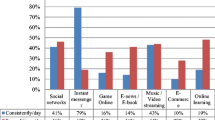Abstract
Currently, there is an increasing trend in the shift from the use of traditional technologies such as a desktop computer towards the use of mobile technologies such as a mobile phone. Nearly all students nowadays own a mobile device and about half of them own more than one. Therefore, students are nowadays well equipped for mobile learning. The aim of this review is to explore the use of mobile phones and/or smartphones and their apps for teaching foreign languages, specifically English, and highlight their benefits and limitations for their use in the teaching of English as a foreign language. This was done by conducting a literature search in the databases Web of Science, Scopus, and ScienceDirect, and consequently, by evaluating the findings of the relevant studies. The findings indicate that the use of mobile phones and/or smartphones and their apps generate positive effects on learning English as a foreign language, especially in the development of learners’ vocabulary and their increased motivation to study. Nevertheless, more longitudinal randomized controlled studies are needed to confirm the efficacy of the use of mobile phone and smartphone apps on specific language skills and knowledge.
Similar content being viewed by others
References
Andujar, A. (2016). Benefits of mobile instant messaging to develop ESL writing. System, 1–14 in press.
Balula, A., Marques, F., & Martins, C. (2015). Bet on top hat – challenges to improve language proficiency. Proceedings of EDULEARN15 Conference 6–8 July 2015 (pp. 2627–2633). Spain: Barcelona.
Burston, J. (2013). Mobile-assisted language learning: a selected annotated bibliography of implementation studies 1994-2012. Language Learning and Technology, 17(3), 157–225.
Cavus, N. (2016). Development of an intellegent mobile application for teaching English pronunciation. Procedia Computer Science, 102, 365–369.
Cheung, S. K. S. (2014). A case study on the students’ attitude and acceptance of mobile learning. CCIS 2014 (pp. 45–54). Heidelberg: Springer.
Chinnery, G. (2006). Going to the MALL: mobile assisted language learning. Language Learning and Technology, 10(1), 9–16.
eMarketer. (2017). Czech Republic just tops Russia for mobile penetration. https://www.emarketer.com/Article/Czech-Republic-Just-Tops-Russia-Mobile-Penetration/1012047.
Hogan, M. (2013). The mobility of business English. The McMillan online conference, Nov. 2013.
Jung, H. J. (2014). Ubiquitous learning: determinants impacting learners’ satisfaction and performance with smartphones. Language Learning and Technology, 18(3), 97–119.
Klimova, B. (2015). Developing ESP study materials for engineering students. Proceedings of 2015 I.E. Global Engineering Education Conference (EDUCON 2015) (pp. 52–57). Estonia, Tallinn: Tallinn Univesrity of Technology.
Klimova, B., & Poulova, P. (2015). Mobile learning and its potential for engineering education. Proceedings of 2015 I.E. Global Engineering Education Conference (EDUCON 2015) (pp. 47–51). Estonia, Tallinn: Tallinn Univesrity of Technology.
Klimova, B., & Poulova, P. (2016). Mobile learning in higher education. Advanced Science Letters, 22(5/6), 1111–1114.
Lee, P. (2014). Are mobile device more useful than conventional means as tools for learning vocabulary? Proceedings of the 8th International Symposium on Embedded Multicore/ Mangcore SoCs (pp. 109–115). IEEE.
Luo, B.R., Lin, Y.L., Chen, N.S., Fang, W.C. (2015). Using smartphone to facilitate English communication and willingness to communicate in a communicate language teaching classroom. Proceedings of the 15th International conference on Advanced Learning Technologies (pp. 320–322). IEEE.
Mehdipour, Y., & Zerehkafi, H. (2013). Mobile learning for education: Benefits and challenges. International Journal of Computational Engineering Research, 3(6), 93–101.
Melby-Lervag, M., & Hulme, C. (2013). Is working memory training effective? A meta-analytic review. Developmental Psychology, 49(2), 270–291.
Moher, D., Liberati, A., Tetzlaff, J., & Altman, D. G. (2009). The PRISMA group. Preferred reporting items for systematic review and meta-analysis: the PRISMA statement. PLoS Medicine, 6, e1000097.
Muhammed, A. A. (2014). The impact of mobiles on language learning on the part of English foreign language (EFL) university students. Procedia – Social and Behavioral Sciences, 136, 104–108.
Oz, H. (2013). Prospective English teachers’ ownership and usage of mobile device as m-learning tools. Procedia-Social and Bahavioral Sciences, 141, 1031–1041.
Pew Research Center. (2017). Mobile fact sheet. http://www.pewinternet.org/fact-sheet/mobile/.
Shih, R. C., Lee, C., & Cheng, T. F. (2015). Effects of English spelling learning experience through a mobile LINE APP for college students. Procedia – Social and Behavioral Sciences, 174, 2634–2638.
Smith, A. (2017). Record shares of Americans now own smartphones, have home broadband. http://www.pewresearch.org/fact-tank/2017/01/12/evolution-of-technology/.
Statista. (2016). Percentage of households with mobile phones in the United Kingdom (UK) from 1996 to 2016. https://www.statista.com/statistics/289167/mobile-phone-penetration-in-the-uk/.
Tarighat, S., & Khodabakhsh, S. (2016). Mobile-assisted language assessment: assessing speaking. Computers in Human Behavior, 64, 409–413.
Tayan, B. M. (2017). Students and teachers’ perceptions into the viability of mobile technology implementation to support language learning for first year business students in a Middle Eastern university. International Journal of Education & Literacy Studies, 5(2), 74–83.
Teodorescu, A. (2015). Mobile learning and its impact on business English learning. Procedia – Social and Behavioral Sciences, 180, 1535–1540.
Wu, Q. (2014). Learning ESL vocabulary with smartphones. Procedia – Social and Behavioral Sciences, 143, 302–307.
Wu, Q. (2015a). Designing a smartphone app to teach English (L2) vocabulary. Computers & Education. https://doi.org/10.1016/j.compedu.2015.02.013.
Wu, Q. (2015b). Pulling mobile assisted language learning (MALL) into the mainstream: MALL in broad practice. PLoS One, 10(5), e0128762.
Yaman, I., Senel, M., & Yesilel, D. B. A. (2015). Exploring the extent to which ELT students utilize smartphones for language learning purposes. South African Journal of Education, 35(4), 9.
Yang, J. (2013). Mobile assisted language learning: review of the recent applications of emerging mobile technologies. English Language Teaching, 6(7), 19–25.
Acknowledgements
This paper was supported by the project Excelence 2017 run at the Faculty of Informatics and Management of the University of Hradec Kralove, Czech Republic.
Funding
Not applicable.
Author information
Authors and Affiliations
Corresponding author
Ethics declarations
Conflict of interest
The author declares that she has no conflict of interest.
Rights and permissions
About this article
Cite this article
Klímová, B. Mobile phones and/or smartphones and their apps for teaching English as a foreign language. Educ Inf Technol 23, 1091–1099 (2018). https://doi.org/10.1007/s10639-017-9655-5
Received:
Accepted:
Published:
Issue Date:
DOI: https://doi.org/10.1007/s10639-017-9655-5




